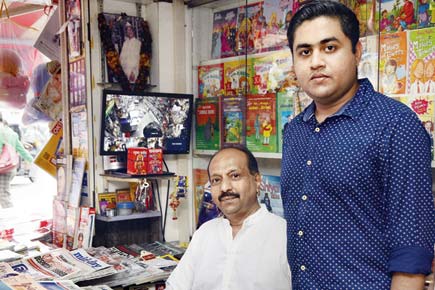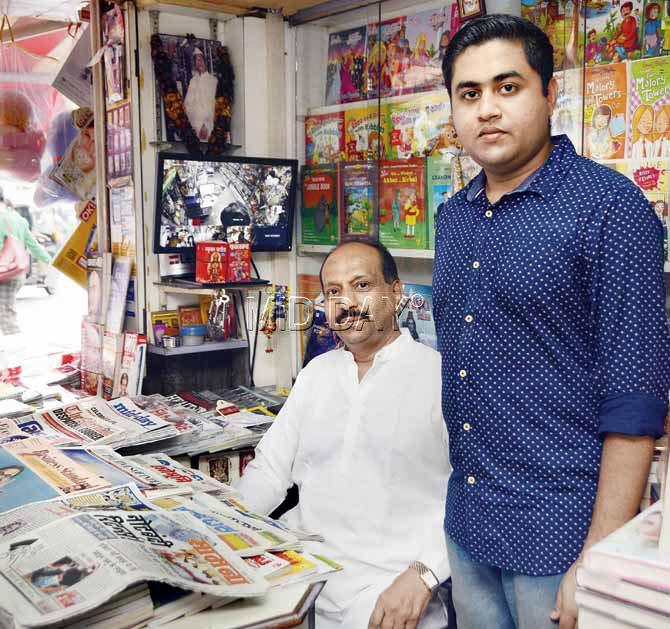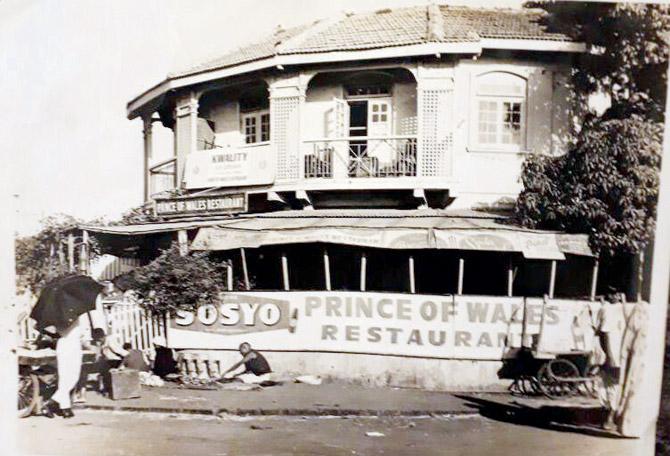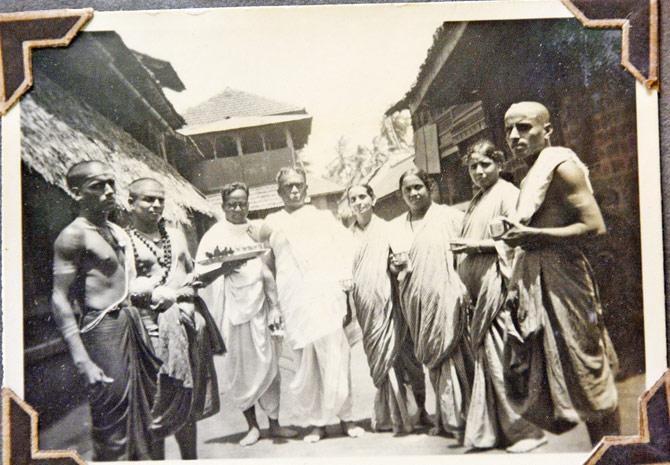What else was early Khar besides a suburb of salt marshes, leafy lanes and old temples? The earliest settlers share memories


Ganesh Nayak with his son Vineet at the VL Nayak newspaper stall near Khar station, the suburb's oldest of its kind. PICS/SNEHA KHARABE
 You could walk past and miss it. I can never. This tiny roofed cottage carries some of my fondest childhood memories. Ninety years after being built by Rana Kaikhushru Dastur, dinky Meher Khushru Villa stands where 2nd Road meets SV Road in Khar. My father's shared ancestry with the Dasturs, belonging to Navsari's priestly Meherji Rana family, meant we visited them often. The hugest hugs from assorted aunts awaited us (and a cousin ever ready to read me stories about a witty-wise goat called Bakor Patel from a Gujarati tome), as did a dining table groaning with goodies.
You could walk past and miss it. I can never. This tiny roofed cottage carries some of my fondest childhood memories. Ninety years after being built by Rana Kaikhushru Dastur, dinky Meher Khushru Villa stands where 2nd Road meets SV Road in Khar. My father's shared ancestry with the Dasturs, belonging to Navsari's priestly Meherji Rana family, meant we visited them often. The hugest hugs from assorted aunts awaited us (and a cousin ever ready to read me stories about a witty-wise goat called Bakor Patel from a Gujarati tome), as did a dining table groaning with goodies.
ADVERTISEMENT
Ranaji's grandson Soli Dastur steers me through parallel and perpendicular lanes numbered 1 to 21. Khar - from the Marathi "khara" or salty (the area was seawater marshy) - unravels in an explosion of Pathare Prabhu, Sindhi, Sikh, East Indian, Parsi, Gujarati and Muslim influences and confluences weaving a patchwork from the 1920s. When the suburb got its railway station in 1924, the Development Department of Bombay declared these "khara" tracts premises to rent.

The stunning little Ghanteshwar Temple set up in the 1950s at one exit of Madhu Park is where the faithful tie bells for prayers answered
Khar stretches east to west from the station till Koliwada, vaulting south from National College on Linking Road to Sacred Heart School northwards. Three centuries ago, the Kolis divided their fishing village into seven gaothans: Dandpada, Patilpada, Madhlapada, Vetalpada, Kotpada, Varinpada and Chauripada, each protected by its deity.
Washing idlis down with filter coffee at Sudhakar Shetty's Vrindavan Hotel outside the station, we cross to Foto Corner, probably Khar's oldest studio. It was started in 1954 by Illustrated Weekly of India photographer Mohan Devdutt Suvarna, who was in the Nizam of Hyderabad's employ before arriving in Bombay. His sons Niranjan and Balkrishna explain he could shoot personalities of the day because of Bandra-Khar's exclusive celebrity circuit in the absence of Versova and Oshiwara. The brothers' prized prints? An autographed portrait of Babasaheb Ambedkar and a still of Nehru saluting at an Azad Maidan parade.

Aspandiar Irani's 1950-established Prince of Wales restaurant now is run by his son Rohinton.
Aligned with Vrindavan is a blue bungalow with Art Deco highlights. Jivan Smruti, the first major project of Lalji Parbat & Co in 1953, was designed for income tax practitioner Jivanlal Shah by Karachi architects KC and CK Lala. Jivanlal's septuagenarian son Vijaybhai recalls the rustic landscape: "Huts, fields and vacant plots everywhere."
As signboards of "To Let" were removed and more plots occupied, Khar sprouted places of worship. A serene presence from the 1920s, the Ramakrishna Math, among the order's oldest centres, hails Swami Vivekananda as a driving force behind its service. Ambedkar Road resident Narayanrao Sonawadekar created the Vivekananda statue of Kanyakumari in actor P Jairaj's Khar-Danda home. Inaugurating that rock memorial in 1970, President VV Giri sanctioned a studio behind St Elias School on 20th Road for the sculptor credited with JN Tata's image in Jamshedpur too.
The Hanuman Temple on 5th Road is where Ravana has burned for 80 Dussehras. A charmingly unusual wishing well of a shrine hugs Madhu Park - Ghanteshwar (Lord of the Bells) Temple from the 1950s - stunningly sheathed in thousands of metal bells. Favours fulfilled, grateful devotees return to tie bells. Recent brass specimens gleam beside counterparts crusted with time and faith.

The Ranes, a prominent old Pathare Prabhu family of Khar, on a trip to Kumta near Mangalore around 1938. To the left of Raosaheb Balaram Mothabhai Rane are his wife and eldest daughter
Fervent prayers must surely be sent up by desperate men of a unique labour mandi here. Dawn to mid-morning, the hopeful jobless hang around Khar station, identified by their bags and boxes. Painters' brushes peep from scruffy thelas, carpenters and plumbers roam with typical toolkits. Few polish walas get furniture glowing as warmly as Narmadeshwar Tiwari, showcasing his skills widely once he was spotted by Khar old-timer Kishore Sutaria in the 1980s.
"Temples should also educate," a gentle 81-year-old Sindhi teacher tells me. He inspires Sanskrit students free of cost at Sunday classes in nearby Khatwari Darbar, the syllabus devised by Bhartiya Vidya Bhavan. The peace exuded belies the flurry of activities at this hub, its sewing shala for girls a big draw as well.
At Satya Vijay Farsan on 1st Road, Prem Joshi reveals his great-grandfather Bhuralal from Falna in Rajasthan opened shop in 1930, tempting a trickle of passersby with puri bhaji and gathia. Across him, Khar Medical Stores serves customers since 1953. Proprietor Ashok Kanuga recounts how his friend VL Nayak, Khar's oldest newspaper distributor and among the city's earliest, would describe the suburb as a pastoral paddy haven.
Venkatesh Nayak's son Ganesh says, "Young people check digital media, but our older clients' morning cup of tea tastes best with a paper in hand." Venkatesh came from Mangalore as a boy of nine with his father Laxman in 1928. When they took to the trade, popular publications were Kesari, Prabhat and two English dailies, The Chronicle and Times of India. Their shelves now stock books and a diverse stash of music.
Govind Jadhav's cart hawking agarbatti and dhoop even packs orders from America. It is squarely within noisy pigeon flutter of the Kabutar Khana springing up in 1998 following a Jain muni's visit. In Sherkat Manzil right across, Aspandiar Irani's 1950-established Prince of Wales restaurant is a takeaway joint today, run by his son Rohinton. Govind relished its chai for 10 paise in the 1970s. This was urban historian Deepak Rao's introduction to Irani cafes - "Dad made me sample its omelette pao and my eyes popped seeing big glass barnis filled with treats. Ask for two lollipops, a third was thrown in!"
Not every community continued in native-prescribed professions of baker, fisherman or farmer. The extremely educated Pathare Prabhus, veteran inhabitants of Prabhu Nagar, are prominent inhabitants, their culture embracing a love for finery, a distinct seafood cuisine and a zest for preserved traditions. At least three generations of Ranes, for instance, are proud of their roots. "I wish you knew the beauty of Khar - full of greenery, with hundred-year-old rain trees shading roads so beautifully, as a kid I never needed a cap on my head," says pathologist Suraina Rane-Malhotra, daughter of general practitioners, Dr Subhash Rane and Dr Rookie Rane, and district president of the Mumbai Mahila NCP. Her grandfather Raosaheb Balaram Mothabhai Rane, finance head of the Secretariat, was "a smart-suited, hat-wearing gentleman. Pathare Prabhu ladies like my grandmother draped a Nauvari saree with black heeled shoes, wore make-up and spoke fluent English unlike their contemporaries from other communities, except for the Parsis."
A doctor legend on 16th Road was homeopath Subodh Mehta, whose admirers floated a public charitable trust and polyclinic in his name in 1970. The research scientist in inorganic chemistry conducted a trial on himself during a nasty flu bout in 1940. Emerging fascinated enough by the results to go deep into the science of homeopathy and consult 400–500 patients a day.
Opposite the Ranes lived a prominent couple: Academy Award-winning scriptwriter Ruth Prawer Jhabvala's husband Cyrus' parents, Savak and Mehra (nee Mehta, she was related to Pherozeshah Mehta). Lawyer Savak Jhabvala was an avowed communist. After she had seven children, Mehra joined the Congress to champion family planning. If Cyrus became an accomplished architect, the rest of the brood boasted a Rhodes Scholar, Herald Tribune editor and UN narcotics division chief, among other examples of brilliance. Their khadi saree and chappals-clad mother spiritedly led Khar Gymkhana's ladies brigade. Residents with a passion for sports - including BG Kher who went on to be appointed the first chief minister (then known as prime minister) of Bombay State - formed this gymkhana in 1928-29, absorbing the Khar Young Cricketers Club within its fold.
At least 35 bungalows of Parsi families like the Jhabvalas dotted the quiet residential suburb when animal activist Arnavaz Poonegar married LIC officer Rustom in 1961. "We went to the station or gymkhana for a soda bottle," she says. From their one-storey home they saw the spire of St Anne's Church on Pali Hill, heard its bells peal - both sight and sound lost forever as Khar grew. "The streets were so uncongested. I coasted along to St Stanislaus School on my bicycle, rolling, rarely pedalling," Rustom remembers.
One of the sweetest success stories from 1948 is Mukhi Tharu's, of Shikarpur in Sindh. Staunchly refusing refugee funds, he mixed gulab jamuns that sold out at camp. Relying on his humble halwai skills, he set up a small stall in the Mumbadevi Temple compound in 1964. Four years later, Tharu Mukhi Bhandar moved to Khar to concoct the most mouth-watering mithai.
Back on Soli's porch we pore over a Gothic-lettered "sanad" ordinance. Issued in 1927 by Lord Irwin, it conferred on his grandfather "the title of Khan Sahib as a personal distinction". Then head clerk of the PWD, Ranaji Dastur astutely picked up town planning developments. That Khar was savvy space to invest in was an idea which finally benefitted five generations of his descendants. And extended family members who can't forget the fun in a palm-fringed little roofed cottage that will always mean a lot.
Author-publisher Meher Marfatia writes fortnightly on everything that makes her love Mumbai and adore Bombay. You can reach her at mehermarfatia@gmail.com
 Subscribe today by clicking the link and stay updated with the latest news!" Click here!
Subscribe today by clicking the link and stay updated with the latest news!" Click here!







